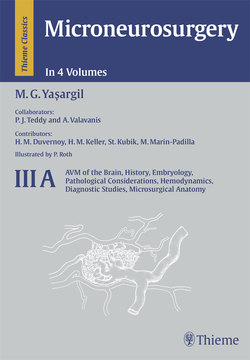Читать книгу Microneurosurgery, Volume IIIA - Mahmut Gazi Yasargil - Страница 8
На сайте Литреса книга снята с продажи.
ОглавлениеContents
Introduction
1 History
A Short History of the Diagnosis and Treatment of Cerebral AVMs
Pre-17th Century
17th–19th Century
Treatment of Extracranial AVM in Earlier and Present Time
Intracranial Angiomas
The Contributions of Virchow and his Contemporaries
Early Clinical Observations on Intracranial AVMs
Surgical Treatment of Cerebral AVMs (1889–1930)
Neurosurgical Approaches Prior to the Introduction of Angiography (1928)
Neurosurgical Treatment of Intracranial AVM Following the Introduction of Angiography (1930)
The Limitations of Surgery
Conservative versus Surgical Treatment
Summary and Outlook
Diagnosis
Surgery
2 Embryology
Miguel Marin-Padilla
A. Embryogenesis of the Early Vascularization of the Central Nervous System
Introduction
Perineural Vascular Territory of the CNS Vasculature
Interneural Vascular Territory of the CNS Vasculature
Composition and Organization of the Pial Vascular Plexus
Vascular Perforation of the CNS Surface by Pial Vessels
Vascular Approach and Contact with the CNS Surface
Endothelial Filopodia Perforation of CNS Surface
In Situ Formation of New Intraneural Vessels
Establishment of the VRC and Interneural Vascular Territory
Intraneural Vascular Territory of the CNS Vasculature
Conclusions
B. Vascular Malformation of the Central Nervous System. Embryological Considerations
Capillary Telangiectasias and Cavernous Angiomas
Venous and Arteriovenous Malformations
Sturge-Weber-Dimitri’s Disease
3 Pathological Considerations
Pathogenesis
Classification of Vascular Malformations
Nomenclature
Classification
The Author’s Classification
Location of AVMs
Localization
Localization of the AVM Within the Brain
I. Surface Lesions (visible on exploration on the surface of the brain)
II. Deep Lesions (invisible at exploration on the surface)
The Nidus
The Concept of Compartments
Compact and Diffuse Lesions
Sizes, Shapes, and Elements of AVMs
Sizes of AVM
Shape
Pure Fistulous AVM
Elements of an AVM
Arterial Feeders
Venous Drainage
Sinuses
Enlargement, Growth, and Regrowth of AVMs
Enlargement
Growth
Pseudo-Growth
True Growth of the AVM
Spontaneous Thrombosis and Regression of AVMs
Multiple AVMs
Multiple Cerebral AVMs
Intracranial and Intraspinal AVMs
Association of Persistent Trigeminal Artery and AVM
Association of Aneurysm and AVM
Intracranial AVM with Stenosis and Occlusion of Major Vessels
Arterial
Moya-Moya Disease
Venous
AVM Associated with Other Pathological Entities
Tumors
4 Hemodynamics
Introduction
Hemodynamics
The Physics of Fluids and Blood Flow
Pressure, Flow, and Resistance
The Nature of Blood
Laminar versus Turbulent Flow
Tortuosity of Vessels
Vascular Distensibility
Cerebral Circulation: Functional Anatomy of the Cerebral Circulation
Neuronal Innervation
Microcirculation
AVM Structure
Enlargement of AVMs
Autoregulation
Normal Perfusion Pressure Breakthrough
Comments on the Normal Perfusion Pressure Breakthrough Theory
Effects of AVMs upon Cerebral Function
Local Mass Effect
Obstruction
Hemorrhage
Vascular Steal
Systemic Effects
Operative Considerations with Regard to Hemodynamics
Preoperative Evaluation
Operative Techniques
Postoperative Care
5 Diagnosis and Follow-up of Patients with Cerebral AVM using Doppler Ultrasound
Herbert M. Keller
6 Neuroradiological Evaluation
A. Valavanis
Computed Tomography
Magnetic Resonance Imaging (MRI)
Cerebral Angiography
Technique
Erroneous Findings
Angiographic Classification
Angiographic Investigation
Limitations of Conventional Selective Angiography
Venous Phase
Associated Aneurysms
Spasm
Summary
7 Microsurgical Anatomy of the Brain
Supratentorial Sulci and Fissures
Fissures
Interhemispheric (Longitudinal) Fissure
Sylvian Fissure
Transverse Fissure
Vascular Patterns Relating to Supratentorial Sulci
Infratentorial Sulci and Fissures
Organization of the Cerebral Microcirculation
The Venous System of the Brain
The Veins of Posterior Fossa
The Collateral Circulation
I Extracranial Arterial Circle
II Dural Arterial Circle
III Basal Cerebral Arterial Circle of Willis
IV Cortical Interhemispherical and Intrahemispherical Arterial Circle
V Cerebellar Arterial Circle
VI Transcranial Arterial Circle
VII Spinal Arterial Circle
VIII Vertebrocervical Arterial Circle
IX Primitive Arterial Circle
Pathology of Collateral System
8 Cortical Blood Vessels of the Human Brain
H. M. Duvernoy
Blood Vessels of the Cerebral Cortex
I Pial Vessels
The Pial Arterial Network
The Pial Venous Network
Pial Vessels: Discussion
Intracortical Vessels
Blood Vessels of the Cerebellar Cortex
I Pial Vessels
II Intracortical Vessels
9 Anatomy of the Calcarine Sulcus
S. Kubik and B. Szarvas
Development
Nomenclature of the Various Parts of the Calcarine Sulcus
The Location of the Meeting Point
Anatomical Variations of the Pars Posterior
Variations in the Terminal Part of the Pars Posterior
Side-Branches and Connections
Pars Anterior of the Calcarine Sulcus
Variations in Course
Connections and Side-Branches
Inner Structure of the Sulcus Calcarinus
Measurements
The Relationship Between the Sulcus Calcarinus and the Calcar Avis, Posterior Horn and Optic Radiation
References
Index
